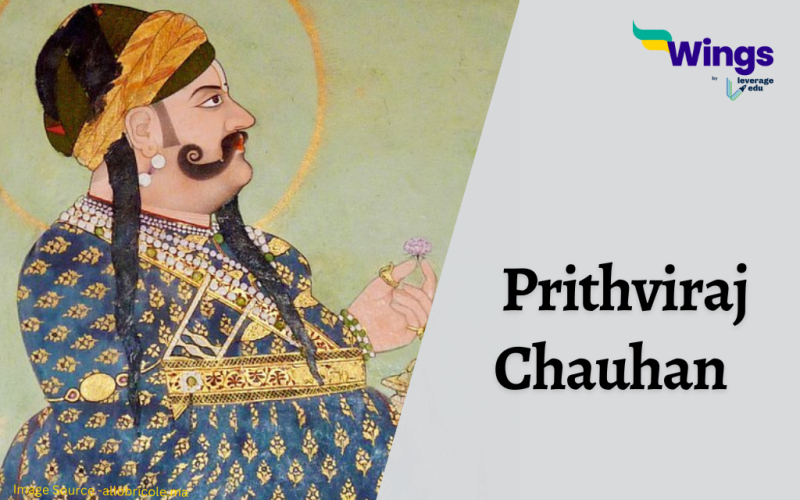Prithviraj Chauhan was also known as Prithviraj III. He was a king who ruled the kingdom from Ajmer to Delhi during the 12th century. He is celebrated for his qualities of archery, military administration and undying love for his queen Sanyukta. Prithviraj Chauhan’s leadership skills and mastery of archery made him an unconquerable king. In this blog, we will delve into the life of Prithviraj Chauhan and the great long battle he fought.
Table of Contents
What was the Early and Political Life of Prithviraj Chauhan?
Prithviraj Chauhan was born in 1166 AD, as estimated by Indian Indologist Dasharatha Sharma with the help of a poem. He was born in the kingdom of Ajmer, Rajasthan and was also known as Rai Pithora. He also belonged to the Chauhan Dynasty. King Someshvara, the king of Chahamanas was his father and Queen Karpuradevi, the princess of Kalachuri was his mother.
From an early age, he displayed leadership qualities and a keen interest in martial arts. Prithviraj received a thorough education in various subjects which included the art of warfare, governance, and diplomacy. His tutors recognized his brilliance and predicted that he would become a great ruler in the future.
At the age of 11, Prithviraj Chauhan ascended the throne of Chauhan after the death of his father. In in early days as king, his mother looked after the administrative department and was supported by many loyal ministers. Among these ministers, Kadambavasa (Kaimasa or Kailashwas) was his Chief Minister. In the year 1177 AD, at the age of 20. Prithviraj took full control of the administration.
Also Read – Slave Dynasty Important UPSC Notes
To whom did Prithviraj Chauhan Marry?
Prithviraj Chauhan fell in love with Sanyukta the princess and daughter of Raja Jaichand of Kannauj. The king of Kannauj did not want her daughter to marry Pritiviraj and thus organized a “Swayamwar”. He invited every eligible king except Prithviraj thereby offending him. But his own daughter rejected all the princes at the event. Later, both Sanyukta and Prithviraj fled to Delhi and got married.
Also Read – Pallava Dynasty: Origin, Achievements, and Legacy
What were the conflicts faced by Prithviraj with Hindu Rulers?
There were many Hindu rulers with whom Prithviraj Chauhan had conflicts during his tenure –
- Nagarjuna – Prithviraj’s cousin Ngarjuna also rebelled against him when he ascended the throne. Nagarjuna took control of the Gudapura fortress in an attempt to get revenge but Prithviraj attacked Gudapur to show his military might.
- Bhadanakas – After the supremacy over Nagarjuna, Prithviraj moved forward to conquer the kingdom of Bhadanakas, which was threatening the Chahamana dynasty of invasion.
- Chandelas of Jejakabhukti – In the year 1182 AD, Prithviraj defeated Paramardi, the Chandela ruler and affiliated them to Gahadavalas.
- Chalukyas of Gujrat – Even though extensive war is not mentioned in any valid sources, but a peace accord is mentioned in Prithviraj Raso between Bhima II of Chalukya and Prithviraj Chauhan.
The Battle of Tarain
Prithviraj’s military genius was most evident in his epic battles against the invader Muhammad Ghori during his Battle of Tarain. The first battle of Tarain took place in 1191 when Prithviraj emerged victorious and captured Ghori. However, due to his compassionate nature, he released Ghori not realizing the dire consequences this decision would have in the future.
In 1192, the second battle of Tarain took place. Despite being outnumbered, Prithviraj displayed extraordinary bravery. However, fate was not on his side this time and he was ultimately defeated.
How did Prithviraj Chauhan Die?
He was captured by Muhammad Ghori and taken as a prisoner to Ghazni. But his indomitable spirit remained unbroken even in captivity and he refused to bow down to his captor. It is said that when Ghori challenged him to aim with his eyes closed, Prithviraj skillfully shot an arrow that struck Ghori’s chest. In retaliation, Muhammad Ghori ordered his soldiers to blind Prithviraj.
According to Prithvi Raso, even in his blinded state, Prithviraj’s spirit remained unconquerable. Upon Ghori’s return to Delhi, Prithviraj was brought before him in chains as a spectacle. Out of revenge, Prithviraj used his remarkable archery skills to kill Ghori, knowing well that death was inevitable for him. Later, Ghori’s followers assassinated Prithviraj. However, there are many other stories surrounding the death of Prithviraj Chauhan. Some say he was killed in prison and some say he ran into exile but was later murdered.
Also Read – Tughlaq Dynasty: Rulers of Delhi Sultanate
What was the Legacy of Prithviraj Chauhan?
Prithviraj implemented various reforms that aimed at improving the lives of his subjects. He believed in the concept of “Dharma” – the righteous path, and he ensured that his administration adhered to these principles. As a result, his kingdom flourished both economically and socially.
Prithviraj Chauhan’s legacy as a warrior-king endures to this day. Known as the “Lionhearted King,” Prithviraj symbolizes the indomitable Rajput spirit and the fierce resistance against foreign invasions.
Also Read – Haryanka Dynasty: Rulers of Magadha Empire
Prithviraj Chauhan in Literature and Folklore
Prithviraj Chauhan’s life has been celebrated in numerous poems, ballads, and folk tales throughout Indian history. The epic poem “Prithviraj Raso” written by Chand Bardai, a court poet, depicts the grandeur of Prithviraj’s kingdom, his military exploits, and his tragic love story with Sanyukta. This literary masterpiece has preserved the memory of Prithviraj Chauhan for generations, ensuring his remembrance as a legendary figure in Indian folklore.

After the death of Prithviraj in the year 1192 AD, the Ghors appointed his son Govindaraj as the successor to the throne of Ajmer. In conclusion, Prithviraj Chauhan’s life journey is a remarkable tale of bravery, resilience, and heroism. His achievements as a ruler, his glorious battles, and his tragic defeat had inspired his clan later.
Relevant Blogs
| Khilji Rulers | Alauddin Khilji |
| Sayyid Dynasty | Babur |
| 50 Interesting History Facts | The Vijaynagar Empire |
| Battle of Panipat | Mughal Emperor Jahangir |
| History of Indian Art | Chola Dynasty |
We hope you liked our blog. If you want to read more articles like this you can visit our general knowledge page on Indian History!
 One app for all your study abroad needs
One app for all your study abroad needs













